How ‘Minx’ Re-created the World of ’70s American Magazine Publishing
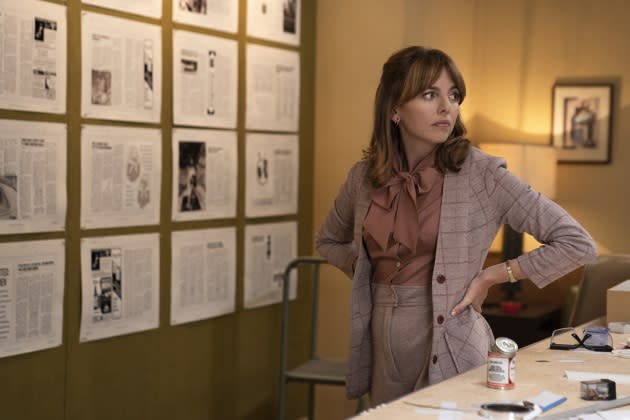
In the world of HBO Max’s period comedy Minx, Jake Johnson’s Bottom Dollar publisher Doug is king — and production designer Jeff Sage, along with set decorator Doug Mowat, helped build his castle.
The first season of HBO Max’s dramedy Minx is most obviously a time capsule of feminism, capitalism, race and sexuality, but it’s also a rare look back into the world of ’70s publishing. Sage tells The Hollywood Reporter when it came to the show’s main publishing environment, Bottom Dollar, they weren’t recreating the “very high gloss Playboy look where they really spent money on photography and beautiful models.” Instead, this was “low-rent soft-pornography.”
More from The Hollywood Reporter
“In the day, that was a thriving business, that whole world of sort of B-magazines where the models aren’t that attractive, the photography is pretty lame, the sets and bathing suits are very simple,” he explained. “So we wanted to get that.”
Sage says the reality of porn publishers like Bottom Dollar at that time is that they were usually “a found space” that wasn’t particularly defined by a single brand. Rather, they had a revolving door of titles leaving their offices to “feel like there was no organizing principle.”
“They weren’t designed as corporate feeling offices. They were thrown together,” he tells THR. “So we always wanted to live within that brick warehouse and make it feel like they didn’t build it out — like it was a circus devolved — and nobody really thought about it. Like, ‘Hey, we can put the reception area here and everybody else can work there. We’ll put a photo there.'”
To “celebrate the mundaneness” of the magazine publisher, neutral warm browns, golds and an “occasional pop of color in the set dressing” were used, according to Sage. Ultimately, it would all be, color-wise, an extension of what was in the original warehouse. But set decorator Mowat says that being set in the early ’70s doesn’t mean Minx was all “avocado and orange chairs.”
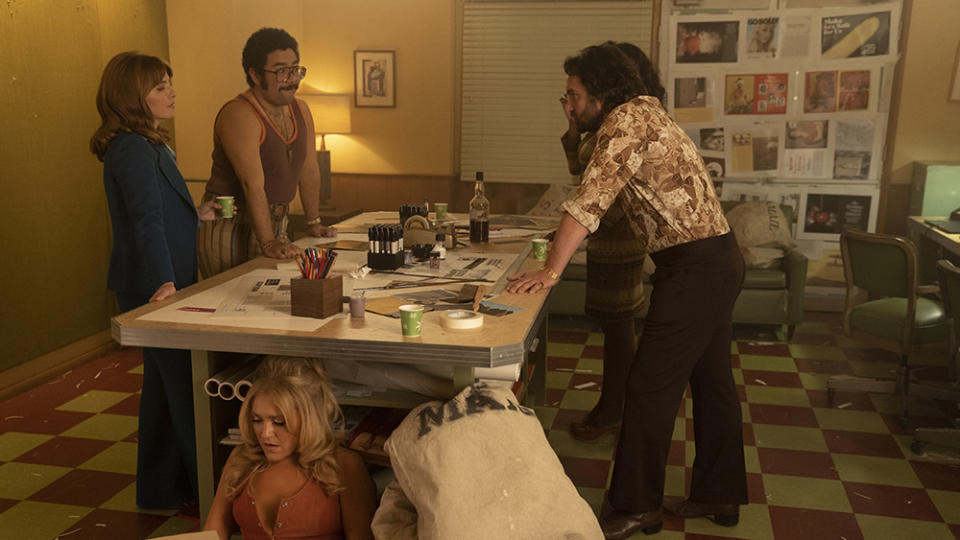
Katrina Marcinowski / HBO Max
“I think for that particular company, it’s a little bit mom-and-pop-ish — it’s kind of small and they’re making do. They’ve got all these different departments crowded into a warehouse,” Mowat tells THR. “They had older things — it’s a world of no computers, all dial phones. So one approach was layering [the age of the set decoration] and bringing in some earlier things. Then a lot of the technology is more cutting edge — radios, the light fixtures.”
Mowat, who took over for Jennifer Gentile after the pilot, said he was able to get much of the original set decoration back, with a few changes. The team turned to the History for Hire prop house to help fill out the Bottom Dollar office with period movie and television lighting, as well as photography and still photo lighting equipment. They also relied on Warner Bros., among others, for props, as well as local antique stores, eBay and Facebook Marketplace for everything from period drafting equipment to the right pencils.
Property master Rich Hobaica helped select the period-appropriate cameras most often found in the hands of Richie (Oscar Montoya), while the set designer said the team added period enlargers, bin trays and more “because they’re still dealing with real printing, not digital,” for the office’s dark rooms. When it came to characters’ desks, that lack of an organizing principle played out by character. “Tina’s desk was very organized and then the same for Joyce — very anal,” he said. “I don’t think you see it that much, but we made it very clean and everything was in its place all the time, whereas other people were just a mess.”
It was a challenging mess, however, as locating items that were in good condition and did not betray their age proved tricky. “A stereo that’s 40 years old, it’s likely scratched up and missing arms and other things. So we did quite a bit of legwork to locate things that were in pristine condition or we had things restored,” Mowat tells THR. “We found a typewriter dealer, we found someone to re-create period phone books for us. Something that people have forgotten about is those offices at the time, especially magazines and newspapers, have tons and tons of phone books from all over the country.”
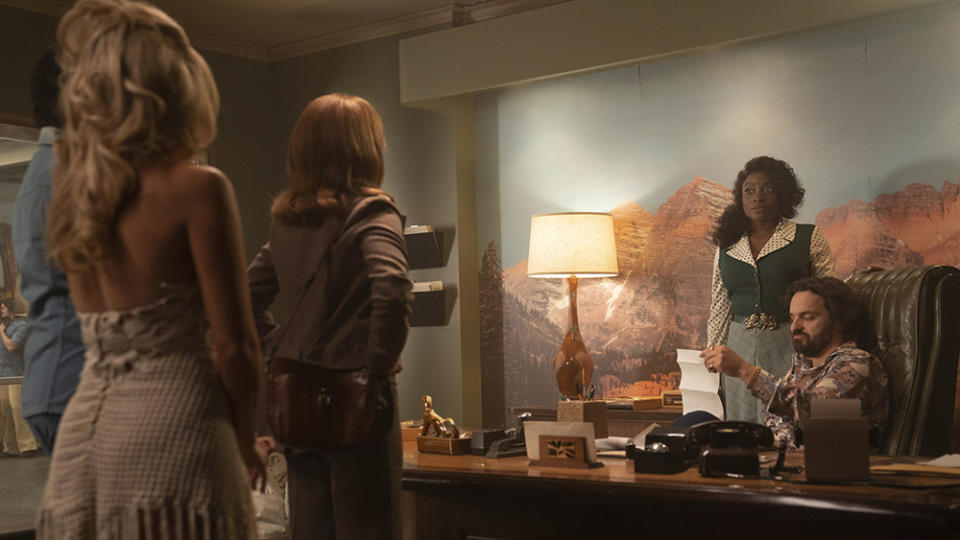
Katrina Marcinowski / HBO Max
While the disorganized principle was the general approach to the Bottom Dollar space, there were three major design exceptions — the conference room, the design room and Doug’s office. “Those three spaces were meant to serve the script specifically as places you really can go and close the door or you can open up all the doors and people can freely come and go, so it would feel more like a bullpen area,” Sage says.
Doug’s office had more organization and features more green — a choice inspired by the team’s decision to make Doug’s car “a rich emerald green.” Mowat, who turned to King Richard’s Antique Vintage Center in Whittier for the room’s ’50s, ’60s and ’70s-based look, called the office’s vibe “more masculine conquistador.”
“If you look in there, he’s got these wrought iron lamps and the furniture is very heavily carved. It’s very much of that time period — that real masculine Spanish influence,” he says. “There are also other animal prints on some pillows and a giant picture of a tiger. Those are the sort of macho elements that we fabricate for Doug in the lounge area, which is kind of a hodgepodge — like people brought stuff from home.”
The design room, where the Bottom Dollar team regularly commenced to review the Minx layout on bulletin boards before it was sent to the printer, also had a stronger sense of organization. “That wanted to be a little bit more drama, a little bit more emphasis because this is where the product was coming together and going out the door,” Sage explains.
The final spot was the conference room, home to Minx‘s famous “penis-medley,” as Sage describes it, where the design could really underscore their vision of putting “action in a little more private place.” During the pilot, and that much-talked-about montage, the team sequestered the space by having the Bottom Dollar ensemble cover the room windows with newspaper “so the rest of the staff couldn’t look in.”
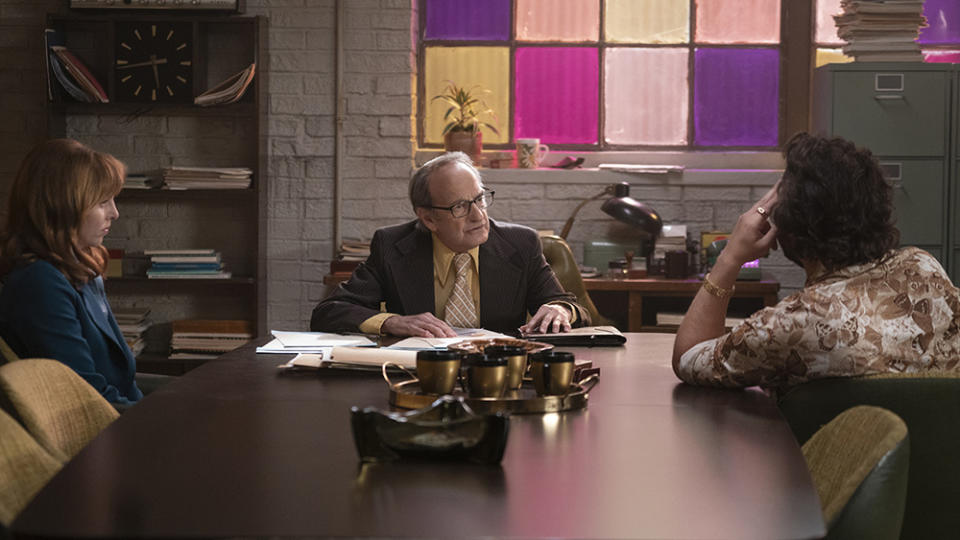
Katrina Marcinowski / HBO Max
“That was a little bit of a way for us to say, ‘OK, even they know this is unusual and different.’ They’re not gonna have it out in the photo area, which is wide open. That’s every day. The topless women that come and go every day — nobody gives that a second look,” Sage says. “That scene, in particular, was like we’re gonna try this new thing and we’re gonna see guys’ penises and this was actually naughty, which is a hilarious concept in a soft porn business.”
Creating the rest of the publishing world beyond Bottom Dollar, then, was mostly focused on conjuring a visual and organizational contrast that could quietly allude to Joyce’s (Ophelia Lovibond) rejection of conventional journalism.
While not based on any particular men’s magazine of the time, the very male-oriented, established Lab Magazine was to be the “anti-thesis of Bottom Dollar,” Mowat says, with its closed-door offices and color palette of burgundy, hunter green and black. Leather sofas and polished, dark wood gave it all “a sense of Old World gentility” for Sage that was comparable to that of a country club, according to Mowat.
“The idea was, with that men’s magazine, to set up a contrast of those choices. This looks like a good life. These guys put their feet up and tell crass jokes. They’re getting paid well,” Sage says. “And there was an idea these guys are pigeonholed in a way. They’ve pigeonholed themselves into an expectation of a career. You’ll get that office for now and when you do better, you’ll get a bigger one or you’ll get the corner one. It sort of suggested to me the ladder. They’re all trying to climb.”
While the color scheme of Joyce’s first job was more pink and white, it also presented the same opportunity to highlight what Joyce was giving up and gambling on by rejecting traditional journalism for the less finished, more organizationally disheveled Bottom Dollar.
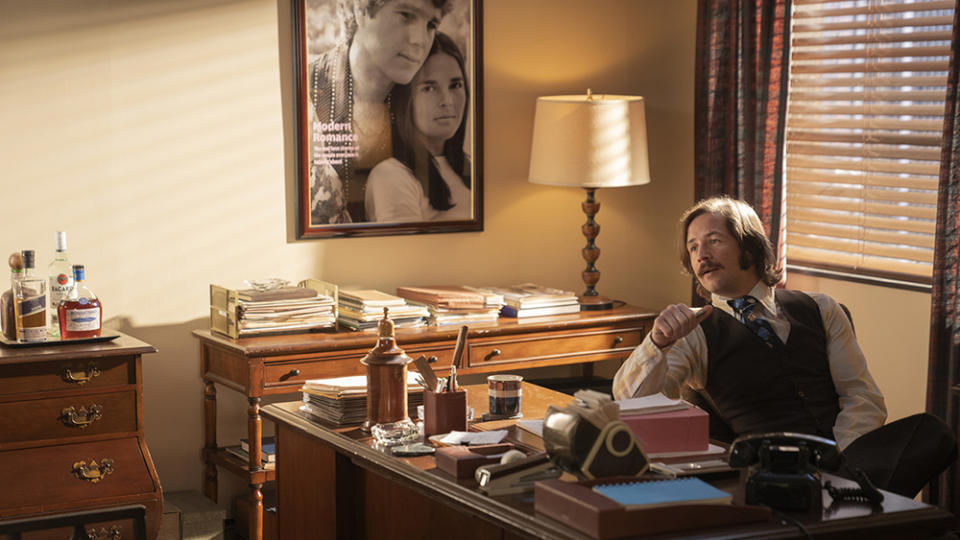
Katrina Marcinowski / HBO Max
“Both the teen magazine and the men’s magazine were intended to have very specific conventional looks to them. They have a corporate sense. People are very concerned about the image of what that magazine projects, not just on the newsstand, but the world that they work in,” Sage says.
As for how they captured journalism beyond the offices, the pilot’s pitch conference — the show’s biggest, most encompassing pictures of ’70s publishing — provides the best idea, underscoring the show’s larger vision of mixing the historical with a modern, fictional imagining. While researching how to build one, Sage says showrunner Ellen Rapoport revealed the pitch-a-thon “was a little bit of an invention.”
“She knew in her research that there were publishing conventions, but the idea of tacking on a pitch-fest was a bit of our creation,” he continued. “We researched a lot of period conventions just for the sense of how they lay out the graphics. From there we filled in the blanks.”
And though they took some creative liberties, the wrapping — like much of the approach on Minx — was true to the period. “We were scouting for places that can hold this kind of an event and we found this particular location, which is the old shipping terminal down in San Pedro. It’s a period building, built I think in 1961,” he says. “Throughout the show, we’re trying to be as authentic to the period as we can.”
Best of The Hollywood Reporter

